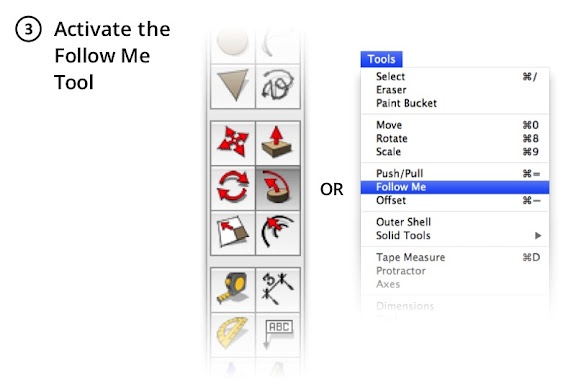
- #Follow me tool sketchup how to#
- #Follow me tool sketchup update#
- #Follow me tool sketchup plus#
- #Follow me tool sketchup professional#
Useful for measuring distance between two points on the model, but even more useful to create visual guide lines from existing points or edges When using another tool, just pressing Space allows to go back to selection mode P = push-pull

Life is too short to click on the tools icons, the following shortcuts are must-know to get any decent productivity in sketchup. The hints below were originally written for the desktop app, but most shortcuts still work in the online version, which is abig relief. After loosing another couple of hours trying to get a working Wine-based setup for Sketchup on Linux, I finally switched to this online app and it is quite fine for the (small) models I create.
#Follow me tool sketchup update#
Update as of October 2018: an online/browser-based version of Sketchup came out (“Sketchup Free”), and it perform surprisingly well. In the end I took the easy way out, I dual-boot to Windows and use Sketchup there. Also, performance when working on large models can become a severe limitation in these conditions. You might be able to use it under linux with Wine, but last time I checked this required a workaround which in the end prevented the use of any additional Sketchup plugin, which is a big drawback for me. Sketchup companion for house (re)modelingĪll right, here is the one (and only) grudge I have against Sketchup: it does not have a native linux client.Rule #5: Clean-up/heal the surfaces as you go.Rule #3: Using groups and components everywhere.
#Follow me tool sketchup plus#
I initially wanted to test it as a simple visual support to remodel one room, and 100 hours later I ended up having modelled the whole house, with every room and associated furniture, plus outdoor areas. Warning: Sketchup can turn out to be quite addictive. I am using the free (as in beer) version currently called Sketchup Make, which is more than enough as far as I am concerned. Obviously there are loads of excellent Sketchup tutorials out there (hint: watch all of the official ones one the sketchup site, and you’re all set), but this just captures the core knowledge that suits my personal (very limited) use of the tool.


#Follow me tool sketchup professional#
Where Sketchup really shines is its ability to be used by a very wide range of users, from enthusiastic newbies like myself that only need to model a few things once in a while and don’t want to invest hundreds of hours into learning an “old-school” 3D modeler, to professional architects and designers using it in their daily workflow.

#Follow me tool sketchup how to#
When you are done with this course you will know how to create a model from a reference image, how to manipulate that model to create professional looking views quickly, and how to utilize some of the advanced tools of SketchUp to create complex shapes and objects.Below are a few notes about basic usage of the Sketchup 3D modeler, mostly as a quick refresher for myself whenever my 3D modeling itch needs scratching, every 6 months or so. You will also learn some of the more advanced features of Sketchup, such as the follow me tool, the array and rotate tools, and other advanced sandbox tool features. Then you will learn how to add topography, furniture, plumbing, millwork, and pre-made assets to help detail your model.įinally you will learn how to set up your model for export from Sketchup for 2d views or into another program, such as 3ds Max. Then, you will learn how to bring in a reference image and use that image as a guide to create walls, mullions, beams and floors to the model. In this course Scott will demonstrate how to use the tools in SketchUp to create, modify, and export both the interior and exterior of a model house.įirst you will learn how to work with toolbars, shortcuts, objects, groups, components, and guides in the SketchUp interface.


 0 kommentar(er)
0 kommentar(er)
